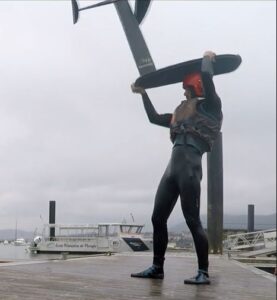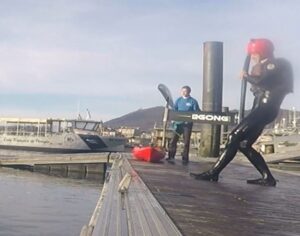If you are still using the low aspect foil you used to learn, you are able to ride for more than 100 meters or more than half a minute, but you end up falling because you are exhausted and can’t go on, it is time to move to a mid aspect foil to continue your progression.
If your goal is to use high aspect 3xl foils or with giant wingspans, do not make the change immediately, first find an intermediate front wing to make the gradual adaptation. A correct foil for a smooth progression would be one that reduces the area of your current foil by 20 to 30%, and increases its wingspan by 5 to 15%. For example, my change was from a Gong Rise XXL with an area of 2500cm2 and a wingspan of 100cm to a Gong Fluid XXL-T with an area of 1900cm2 and a wingspan of 105cm. Looking at the numbers it doesn’t seem like much of a change, but the thickness of the foil also decreased a lot and believe me, the difference was very noticeable.
Don’t use the stabilizer on your low aspect foil, it will surely be too big for a mid aspect front wing, which will slow down your flight and make the foil stop dead as soon as you lose speed.
The change is not going to be automatic, in your first jumps or even on your first day you will feel that everything you have learned has been useless, your pumping will seem inefficient, you will feel that the board is going to one side and you will lose balance immediately, it will even seem that the dock start that you already had under control has been forgotten again. It is completely normal.
Since your state now returns to how it was when you started, even if it is hard, you will have to return to the mentality of when you started; patience, perseverance and trying again and insisting even if it seems to you that you are not making progress. Go back over one by one the 9 objectives that we set ourselves in the initiation tutorial to see if we are not doing any of them correctly. If you do this you will experience all the evolution you had when you started, small progress, small advances, progressively increasing distances and times. The difference is that the speed of progress will go 10 times faster.
Some differences that I have noticed:
- The MA foil is more sensitive to a bad initial position of the feet, so you have less chance of correcting it on the fly.
- The MA foil doesn’t allow for big oscillations on the foil, pumping has to be done with less exaggerated movements. Especially on the downhill, if you tilt it down too abruptly it can lose power and the foil can stop. Here it helped me not to think so much about lowering the tip but more about sliding the board with both feet forward (a little more force with the back one) just to give it speed.
- The MA foil goes more easily to the sides and therefore it is easier to lose balance. I think that the change to a smaller stabilizer also influences this and it is not all the fault of the front wing, but the good news is that in a couple of practice sessions you can tame it and feel the same stability again.
- When the foil loses speed it stops dead as if you had lost the front wing. The low aspect gave you a margin of error in which you still had a chance to get it up to speed again if you did it right.
- The MA foil requires more speed, when you give it that speed the two previous differences tend to disappear.
I’ll tell you the steps of my progression and my mistakes so you can see what I went through, but yours may be different:
- On the first jumps at 3 or 4 pumps, the foil would stop dead, as if I had hit something or lost the front wing. This was because I was using the same stabiliser as in the low aspect (stab x-over L of 46cm and 350cm2 of area), and it was too big as you can see in this video. When changing to a shorter one, sometimes the sudden stop still happened to me, but not at 3 or 4 pumps, but later on when for some reason my pumping was too slow.
- I was unable to correct a bad initial foot position, so I had to concentrate again on doing a good initial jump by looking at the board just before putting my feet down.
- The foil would go to the side very quickly, and I couldn’t concentrate on doing a correct pumping because I had to constantly correct the deviation to the left and then to the right. This was reduced in successive jumps based on practice.
- The foil was lifting quite well when I took weight off it, but I realized that it was not gaining speed, so I had to focus my mind again on pressing down the foil to increase the speed on the way down.
My first session with the MA was a disaster, but in my second session with the correct stabilizer and by insisting on a session of more than 2 hours I managed to reach the level I had with the low aspect. That was based on fast and aggressive pumping in which I ended up falling because my legs were so tired that they were no longer able to maintain balance. But once I had mastered the mid aspect foil I could focus on improving performance from the next session.
Here is the video of my 20th session (since I started pump foiling), my second day with the MA (Gong Fluid XXL-T with an area of 1900cm2 and a wingspan of 105cm and a 40cm gong stabilizer with an area of 250cm2.



